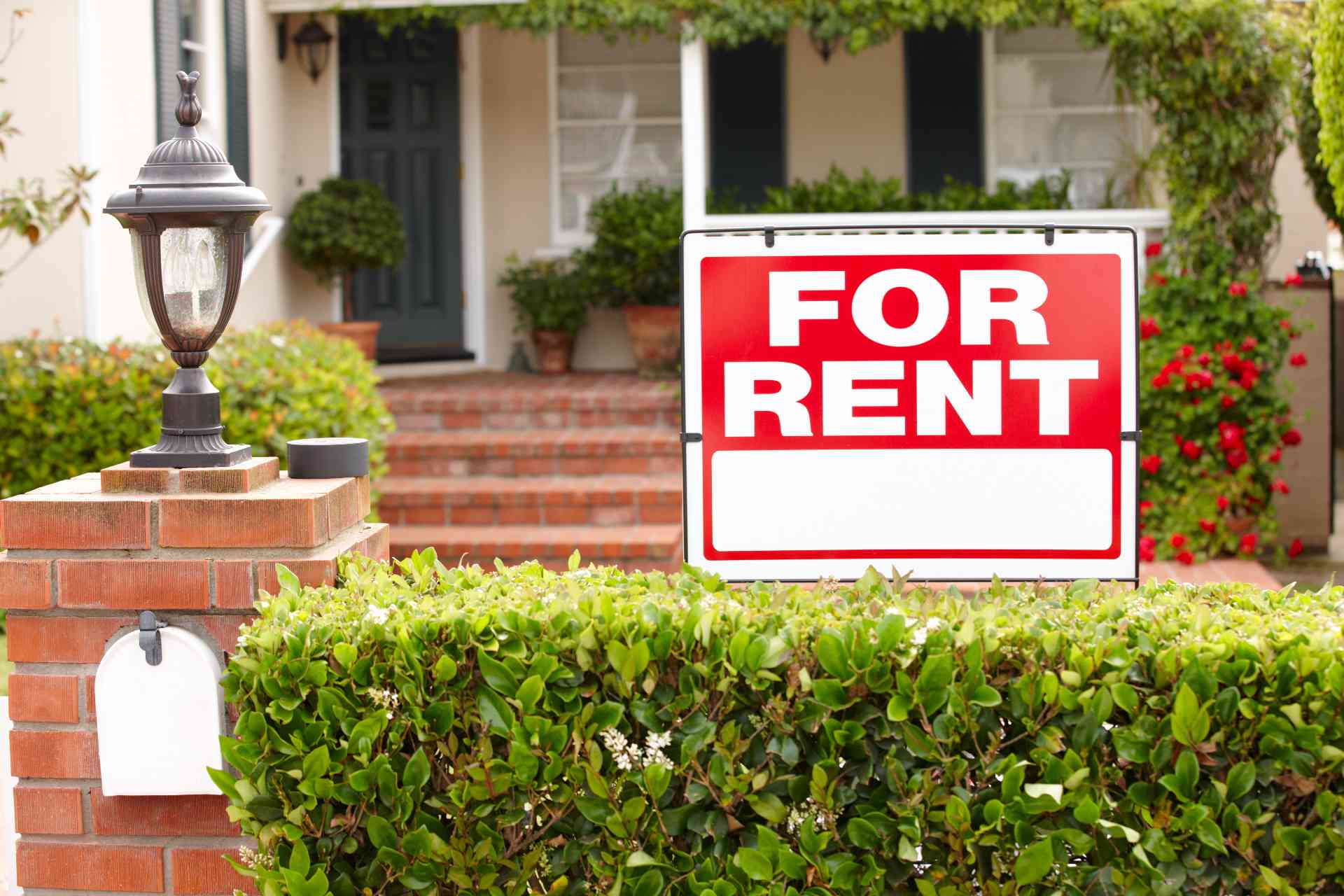Choosing the right flooring for a rental property can make a lasting difference in its appearance and performance. Floors take more wear and tear than any other surface in a home, and landlords need options that hold up to frequent tenant turnover, spills, and everyday use. The best flooring for rental property should be durable, easy to maintain, and cost-effective while still giving the space a clean, inviting look that helps attract reliable tenants.
In this guide, we’ll explain what to consider before choosing flooring, review the best and worst materials for rental homes, recommend options for specific rooms, and share tips to help landlords protect their investment and keep units looking fresh between tenants.
Key Factors to Consider When Choosing Rental Property Flooring
Landlords face a unique challenge when selecting flooring. It has to look good, fit the property’s style, and stand up to heavy use from tenants who may not treat it as carefully as a homeowner would. Before deciding on a material, it’s important to consider the following factors:
- Durability: The best choices for rental properties are durable flooring options that resist scratches, dents, and wear from foot traffic, pets, and furniture.
- Maintenance: Easy-to-clean surfaces help landlords save time and money between tenants. Look for flooring that resists stains and can be quickly refreshed with a simple flooring maintenance routine.
- Cost-effectiveness: Upfront cost matters, but so does lifespan. A slightly higher investment in durable materials often pays off by extending the time between replacements.
- Aesthetic appeal: Flooring contributes significantly to a property’s overall look. Neutral, modern finishes appeal to the widest range of tenants and make units easier to rent.
- Location and use: The property type and climate also affect the choice. A multi-family apartment may benefit from sound-absorbing materials, while a single-family home or short-term rental might need flooring that handles moisture or pets.
- Moisture resistance: Especially important in bathrooms, kitchens, and basements, where spills or humidity can cause damage to certain flooring types.
- Noise reduction: Ideal for multi-unit buildings to minimize sound transfer between floors and improve tenant comfort.
- Installation and replacement ease: Floors that are simple to install or replace can help reduce downtime between tenants and lower maintenance costs.
Best Flooring Options for Rental Properties
Every rental property has different needs based on its layout, tenant turnover, and overall value. The ideal flooring should combine practicality with style, offering durability that holds up under daily wear while keeping maintenance costs low. Below are the most common flooring materials landlords choose, each with unique benefits that make them suited for specific types of properties and rooms.
Luxury Vinyl Plank Flooring
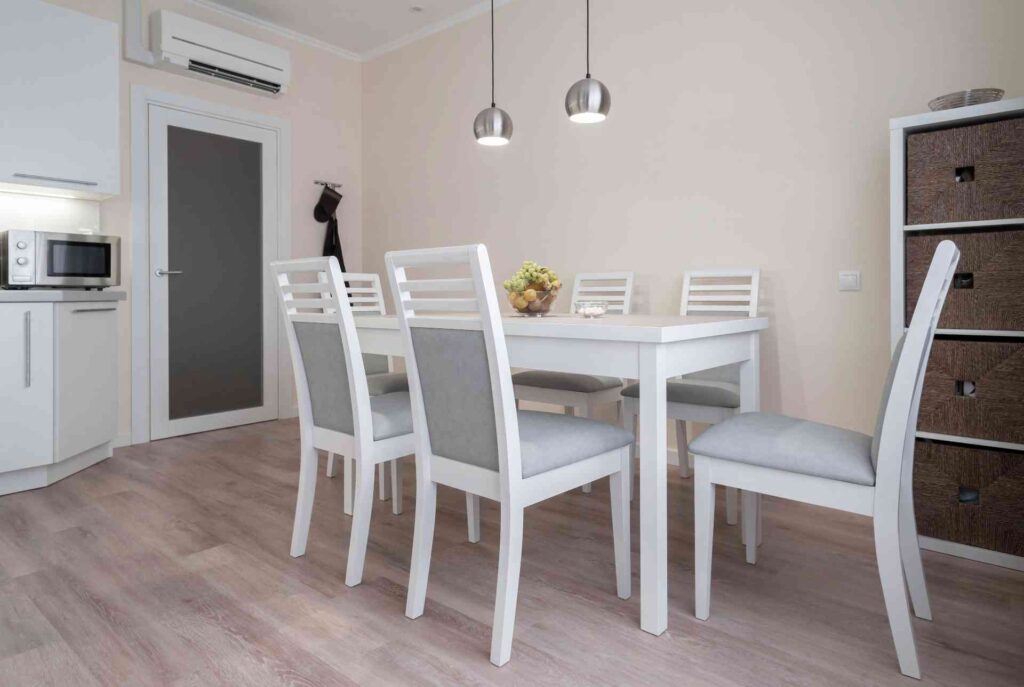
Luxury vinyl plank (LVP) and luxury vinyl tile (LVT) are among the most popular choices for rental properties due to their ability to balance durability, style, and low cost per square foot. Made from several layers of synthetic materials, luxury vinyl flooring typically features a wear layer for protection, a printed design layer that mimics the appearance of wood or stone, and a waterproof core that resists moisture damage.
This type of flooring can handle heavy foot traffic, pet activity, and frequent cleaning without showing wear. Its waterproof nature makes it suitable for kitchens, bathrooms, and basements, while its realistic wood or tile appearance enhances a property’s overall appeal. LVP is also easy to install and replace, which helps landlords save time and money during turnover periods.
Laminate Flooring
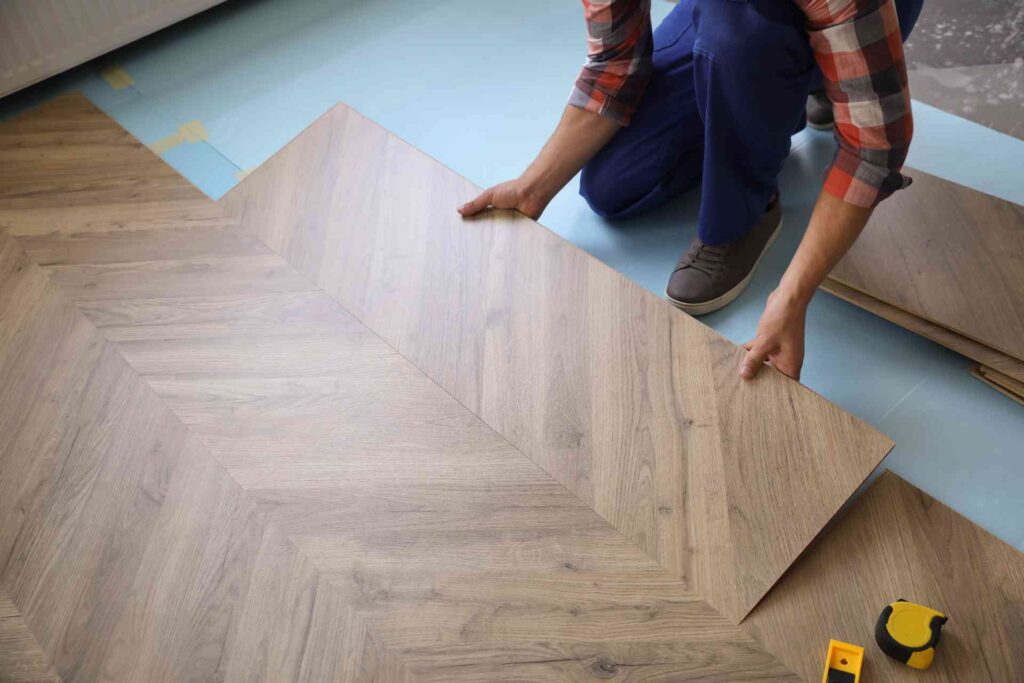
Laminate flooring is another cost-effective and attractive option for rental properties. It’s made from a core of high-density fiberboard topped with a photographic layer that mimics hardwood, tile, or stone, and sealed with a tough protective coating. This layered structure gives the laminate excellent resistance to scratches, fading, and dents — making it a reliable choice for living areas and bedrooms.
Its easy click-and-lock installation system makes it simple to install or replace individual planks, which is ideal for quick updates between tenants. But while laminate flooring is durable, it’s less moisture-resistant than luxury vinyl plank. Prolonged exposure to water can cause the boards to swell or warp, so it’s best used in dry spaces rather than bathrooms or kitchens.
Tile Flooring
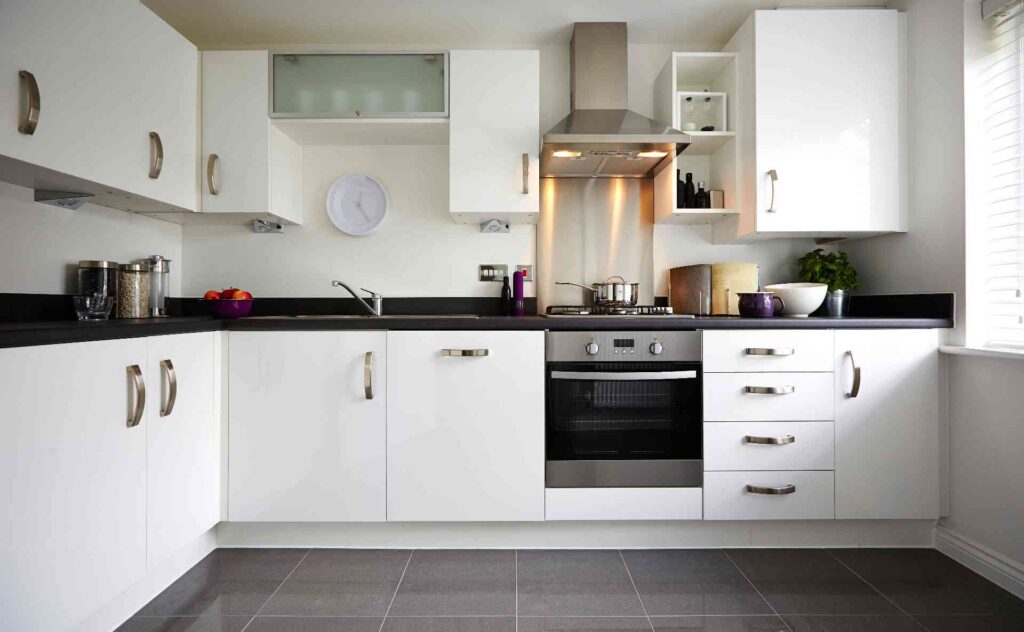
Tile flooring is an excellent flooring option for kitchens, bathrooms, and entryways.. It’s typically made from either ceramic or porcelain, both of which are fired at high temperatures to create a hard, nonporous surface that resists stains, moisture, and wear.
Porcelain tile is denser and less absorbent than ceramic, which gives it superior durability for high-traffic or wet areas. Both types are available in countless colors, sizes, and patterns, allowing landlords to match the look of natural stone or wood at a lower cost. Tile is easy to clean and rarely needs replacement, but it can feel cold underfoot and requires proper grout maintenance to prevent discoloration or mildew.
Engineered Hardwood
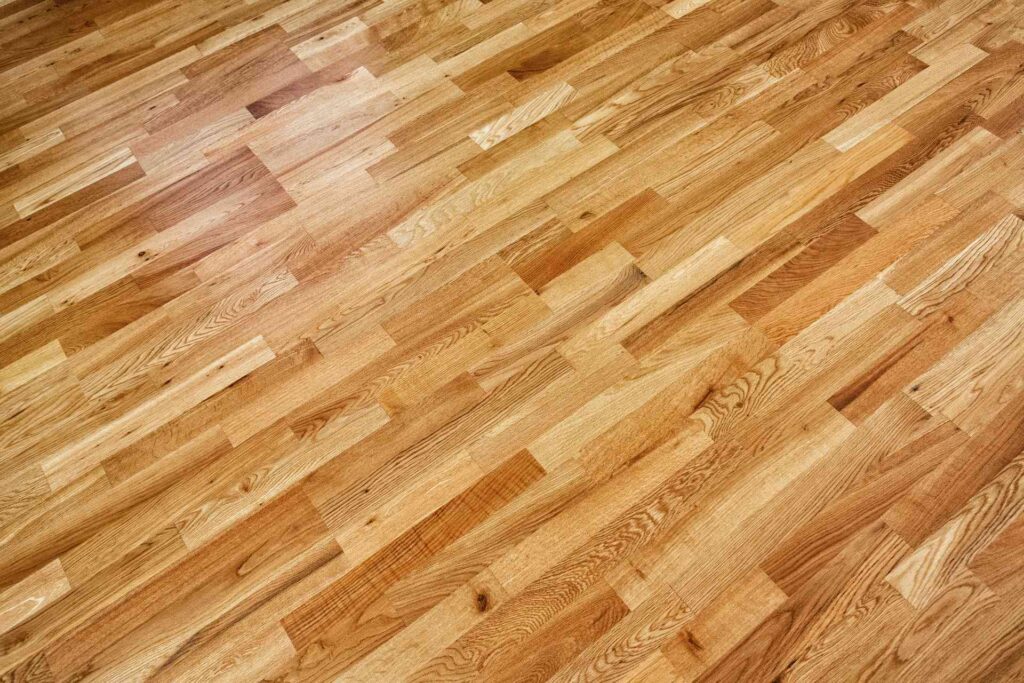
Engineered hardwood flooring offers the natural warmth and beauty of real wood with better stability and moisture resistance than traditional solid hardwood. It’s constructed from a thin layer of genuine hardwood bonded to multiple layers of plywood or fiberboard, creating a durable structure that resists warping and expansion caused by humidity.
This type of flooring is ideal for higher-end rental properties where aesthetic appeal matters. It delivers the same upscale look as solid hardwood but at a lower cost and with easier installation. However, engineered hardwood is more prone to scratching than vinyl or laminate, so it’s best suited for rentals without heavy pet traffic or excessive moisture exposure. Regular cleaning and occasional refinishing help maintain its appearance and extend its lifespan.
Carpet
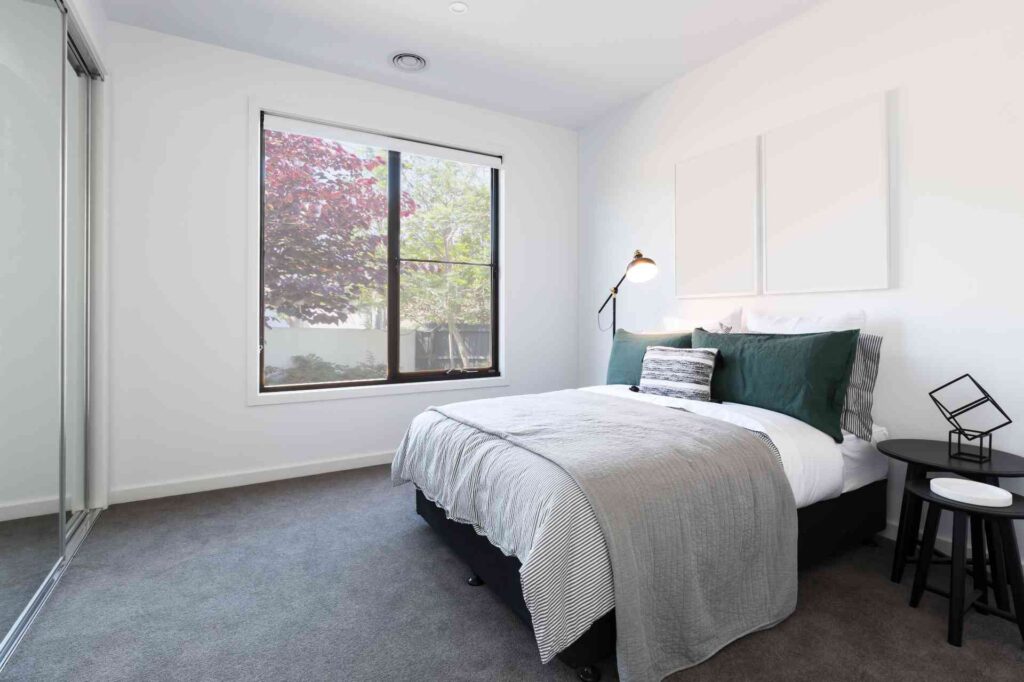
Carpet remains a practical and budget-friendly flooring choice for certain areas of a rental property, particularly bedrooms, living rooms, and low-traffic spaces. It provides warmth, comfort, and noise reduction, which is especially beneficial in multi-family buildings or upper-level units. Most rental-grade carpets are made from synthetic fibers such as nylon or polyester, which are more durable, stain-resistant, and affordable options than natural materials like wool.
While carpet adds comfort and insulation, it typically requires more maintenance and frequent replacement compared to hard flooring. Spills, pet stains, and general wear can build up over time, especially in common areas. Choosing darker, neutral tones can help hide minor stains and wear between tenants, while opting for a midrange carpet quality ensures a good balance between cost and lifespan.
What’s the Best Rental Property Flooring by Room Type?
Different rooms in a rental property experience different levels of traffic, moisture, and wear. Choosing flooring based on how each space is used helps extend its life and minimize upkeep. Here’s a breakdown of the best options for each area of a rental home:
| Room | Best Material | Why It’s Best | Features to Look For |
| Living areas | Luxury vinyl plank (LVP) | Choose warm or neutral wood tones with a light texture and a matte finish to hide scuffs | Choose warm or neutral wood tones with light texture and a matte finish to hide scuffs |
| Kitchens | Tile | Completely waterproof and resistant to spills, heat, and grease, making it ideal for busy cooking spaces | Look for porcelain or ceramic tile with a slip-resistant surface and light-to-medium tones |
| Bathrooms | Porcelain tile | Withstands high foot traffic and moving furniture while maintaining a clean, modern appearance that tenants appreciate | Select smaller tiles for better traction, and use grout treated with mold- and mildew-resistant sealant |
| Bedrooms | Carpet | Adds warmth, quiet, and comfort underfoot, helping bedrooms feel cozy and inviting | Opt for medium-pile carpet in a neutral color with stain protection and tight, durable fibers |
| Basements | Waterproof vinyl plank | Protects against moisture and temperature fluctuations common in below-grade spaces | Pick planks with a rigid waterproof core, darker tones, and a subtle texture to hide dust |
| Entryways & mudrooms | Tile | Stands up to wet shoes, dirt, and frequent cleaning without losing appearance | Choose textured or matte tiles in darker tones for traction and easier maintenance |
| Laundry rooms | Waterproof vinyl | Handles water drips, detergent spills, and vibration from appliances without damage | Look for 100% waterproof construction and a smooth surface for quick cleanup |
| Dining areas | Engineered hardwood | Creates a polished, connected look with nearby spaces and resists chair scuffs and spills | Choose medium-tone finishes with a durable top coat and subtle grain for easy blending |
Flooring Options to Avoid in Rental Properties
Not every flooring material is suited for rental use. Some options look beautiful at first but end up costing more in repairs, replacements, or maintenance over time. When durability and easy upkeep are priorities, landlords should avoid materials that can’t handle everyday wear, moisture, or frequent tenant turnover. The following flooring types are best left out of rental homes:
- Solid hardwood: Although solid hardwood has an elegant, timeless appeal, it can be easily scratched by furniture or pet claws and can warp when exposed to moisture. Refinishing between tenants adds unnecessary cost and downtime, making it impractical for most rentals.
- Natural stone: Materials like marble and travertine offer luxury appeal but require constant sealing and careful cleaning. They are prone to staining, etching, and cracking, which can quickly diminish their appearance.
- Low-quality carpet: Cheap carpet wears down fast, shows dirt and stains easily, and often needs replacing after only one or two tenant turnovers. It can also hold odors, making it harder to prepare a unit for new renters.
- Unsealed laminate: Standard laminate flooring without waterproof protection swells or buckles when exposed to spills or humidity. It’s better suited for owner-occupied homes where maintenance is more consistent.
- Cork or bamboo: These eco-friendly materials may look appealing, but they scratch, dent, and absorb moisture easily. Heavy furniture, pet activity, or even minor spills can cause permanent damage.
- Sheet vinyl: Though inexpensive upfront, sheet vinyl is thin and can tear or bubble under furniture or appliance weight. Repairs are difficult, often requiring full replacement of the sheet.
- High-gloss finishes: Floors with glossy finishes — whether tile, vinyl, or hardwood — show every scuff, scratch, and footprint. They require constant cleaning to stay presentable and quickly lose their shine in high-traffic rental spaces.
Top 10 Tips to Get the Most Out of Your Flooring Investment
Even the most durable floors need care to stay in good condition. For landlords, small steps can go a long way toward extending the life of flooring and keeping units attractive for new, potential tenants. These ten tips help protect your investment and reduce long-term maintenance costs.
- Choose neutral colors: Light to medium tones make rooms feel bright and hide dirt, scuffs, and everyday wear better than darker finishes.
- Invest in quality underlayment: A proper underlayment improves comfort, sound absorption, and moisture resistance, helping flooring last longer.
- Keep extra material on hand: Save leftover planks, tiles, or carpet rolls for quick patch jobs between tenants.
- Use area rugs and furniture pads: Prevent scratches, dents, and scuffs in high-traffic zones and under heavy furniture.
- Perform routine inspections: Check flooring during move-outs and periodically during long leases to identify and fix small issues early.
- Clean with approved products: Use cleaners designed for each flooring type to avoid damaging protective finishes.
- Seal or reseal when needed: Tile grout, engineered wood, and certain vinyl types benefit from periodic resealing to resist stains and moisture.
- Address water damage immediately: Fix leaks and dry spills quickly to prevent warping, swelling, or mold growth.
- Educate tenants on maintenance: Provide simple cleaning instructions and move-in reminders to reduce long-term wear.
- Plan for replacement cycles: Buy your rental flooring with renovation costs in mind. Track installation dates and schedule updates proactively before flooring becomes visibly worn or outdated.
Upgrade Your Rental Property With Flooring That Lasts
The best flooring for a rental property combines durability, easy maintenance, and visual appeal that attracts reliable tenants. Materials like luxury vinyl plank, tile, and engineered hardwood can handle heavy use while keeping your property looking modern and well cared for.
Choosing the right flooring for each room and investing in proper upkeep helps reduce long-term costs and protect your investment. If you’re in the Seattle area, visit Builders Interiors or contact our team for expert help selecting durable, stylish, and cost-effective options that fit your rental property and your budget.


